January 2025
The global pharmacy automation market size is accounted at USD 6.93 billion in 2025 and is forecasted to hit around USD 16.48 billion by 2034, representing a CAGR of 10.08% from 2025 to 2034. The North America market size was estimated at USD 2.59 billion in 2024 and is expanding at a CAGR of 10.20% during the forecast period. The market sizing and forecasts are revenue-based (USD Million/Billion), with 2024 as the base year.
The global pharmacy automation market size was calculated at USD 6.31 billion in 2024 and is predicted to reach around USD 16.48 billion by 2034, expanding at a CAGR of 10.08% from 2025 to 2034.
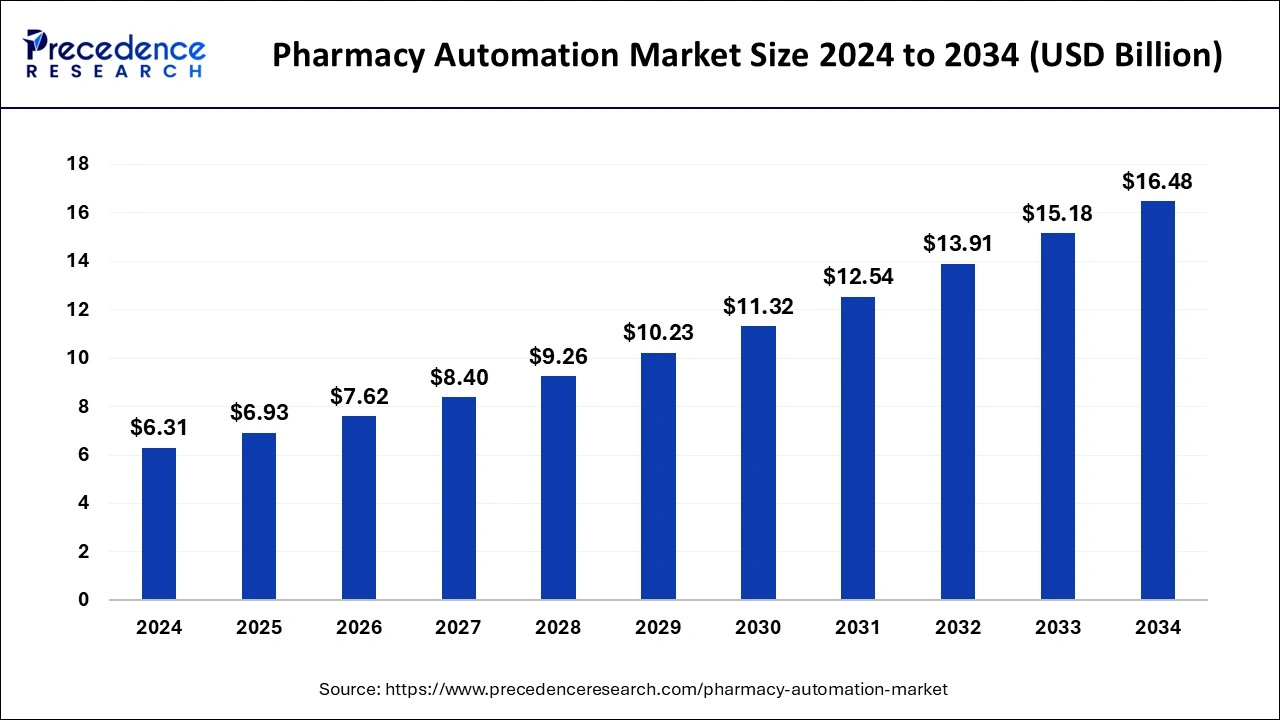
The U.S. pharmacy automation market size was exhibited at USD 1.81 billion in 2024 and is projected to be worth around USD 4.82 billion by 2034, growing at a CAGR of 10.29% from 2025 to 2034.
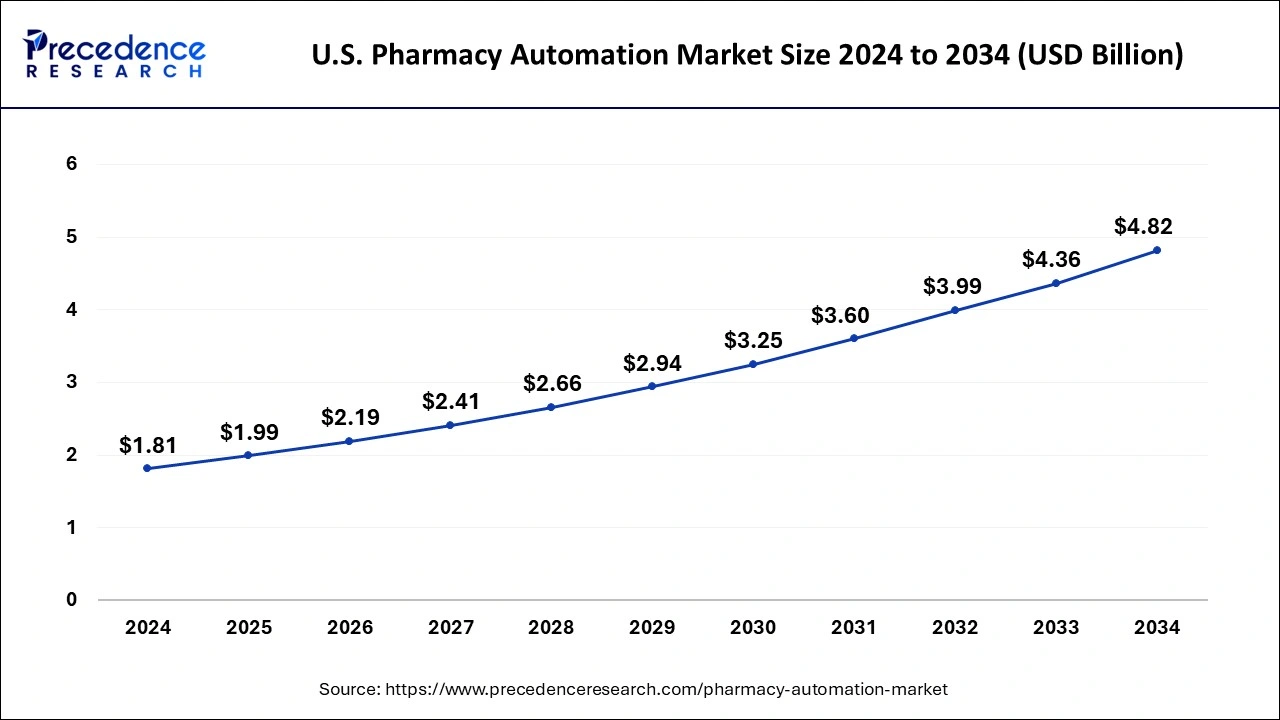
North America dominated the pharmacy automation market in 2024. The U.S. dominated the pharmacy automation market in North America region. More than 100,000 suspected drug errors are reported each year in the U.S., as per the U.S. Food and Drug Administration. Furthermore, according to a study conducted by Johns Hopkins University, drug errors cause over 250,000 deaths in the U.S. each year. As a result, it’s one of the nation’s major causes of death, which is driving the growth of pharmacy automation market in North America region. In addition, technological developments are also driving the expansion of North America pharmacy automation market. For example, Omnicell’s XT series automated dispensing system has been installed in five of Duke University Hospital’s hospitals in the U.S. These updated cabinets have a 30% higher capacity and can hold 30% more pharmaceuticals in the same footprint as the previous design.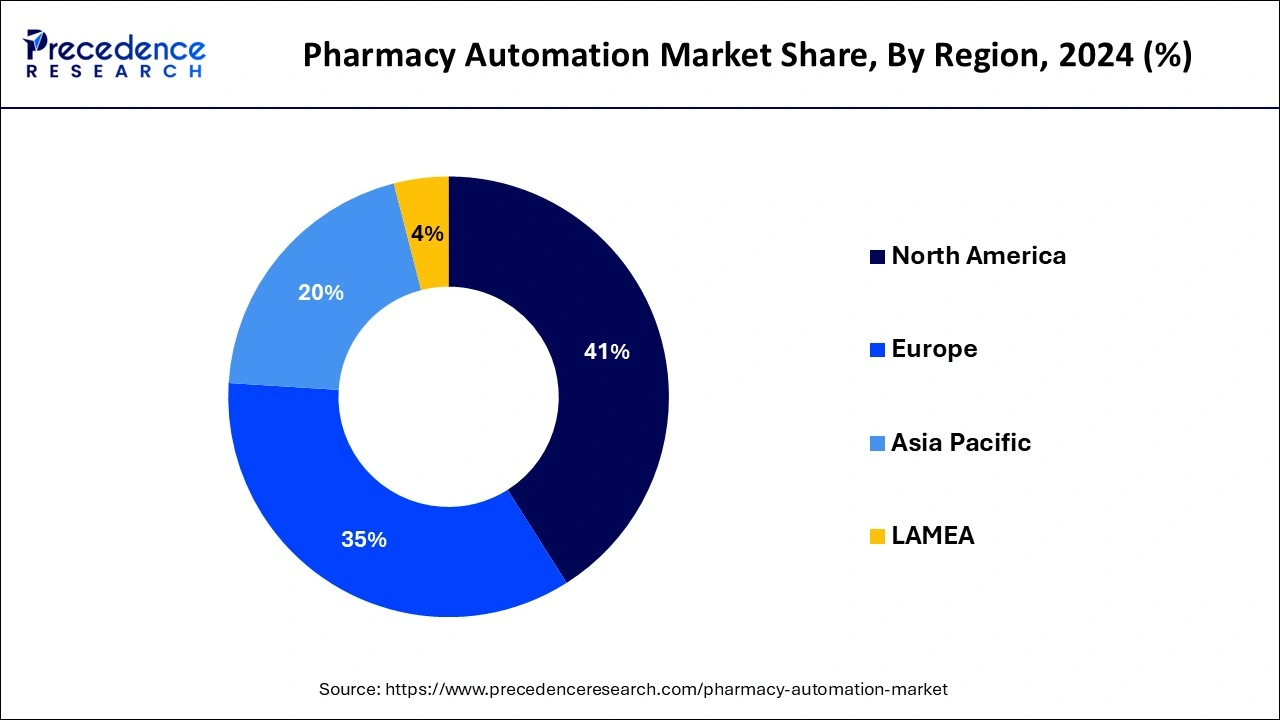
Asia-Pacific, on the other hand, is expected to develop at the fastest rate during the forecast period. China dominates the pharmacy automation market in Asia-Pacific region. The pharmacy automation market in Asia-Pacific is being driven by growing geriatric population and rising healthcare funding and investments. In addition, the rising requirement for minimizing medication errors is driving the growth of Asia-Pacific pharmacy automation market. Medication errors, account for 2.0% to 3.0% of healthcare centers or hospitals admissions in Australia, as per the Australian Commission on Safety and Quality in Healthcare.
The growth of global pharmacy automation market is being driven by the growing need for device that helps in reducing medication errors. Furthermore, the growing geriatric population as well as growing adoption of automated devices and innovative technologies is also contributing towards the growth of global pharmacy automation market. The rising healthcare expenditure is also driving the growth and development of worldwide pharmacy automation market over the forecast period.
Another factor driving the growth of global pharmacy automation market is the expansion of pharmaceutical sector all around the globe. As per the Indian Brand Equity Foundation, Indian companies exported pharmaceuticals worth $17.27 billion from 2017 to 2018, and this figure is predicted to rise by 30% by 2020 to $20 billion. The thriving pharmaceutical business is expected to boost the growth of worldwide pharmacy automation market.
The geriatric population has risen globally. As a result, the number of life threatening and chronic disorders is on the rise, as is the number of prescriptions prescribed. As per the study of Economic analysis of the prevalence and clinical and economic impact of medication error in England, released in June 2021, the National Health Service in England makes an estimated 237 million prescription errors per year, resulting in hundreds of fatalities. As a result, pharmacies and hospitals are implementing new pharmacy automation technology to cut costs while increasing patient safety.
The increased mergers and acquisitions as well as an increase in the number of partnerships between companies to extend their product capabilities, are predicted to drive the growth of global pharmacy automation market. The key market players, particularly in emerging nations, are focusing on ongoing product development while supplying products at competitive rates.
| Report Coverage | Details |
| Market Size in 2025 | USD 6.93 Billion |
| Market Size by 2034 | USD 16.48 Billion |
| Growth Rate from 2025 to 2034 |
CAGR of 10.08% |
| Largest Market | North America |
| Fastest Growing Market | Asia Pacific |
| Base Year | 2024 |
| Forecast Period | 2025 to 2034 |
| Segments Covered | Product, End Use, Geography |
| Regions Covered | North America, Europe, Asia-Pacific, Latin America, and Middle East & Africa |
Rising requirement for prescription data management solutions
Pharmacy automation systems with robust prescription data management capabilities help enhance patient safety. By automating the prescription filling process, these solutions minimize the risk of medication errors, such as incorrect dosages or drug interactions. Prescription data management solutions can also provide real-time access to patient medication history and alerts for potential issues, promoting better decision-making and patient care. With increasing regulations and the need for stringent data management, pharmacies are turning to automation to simplify compliance processes and reduce the risk of errors or non-compliance. Thus, the rising requirements for prescription data management solutions are observed to drive the growth of the market.
In June 2024, an international cloud-based provider, BoomerangFX announced its partnership with Dr.First in order to launch e-prescribing systems for aesthetic medicines for North America.
Emphasis on medication error reduction
As healthcare providers focus on improved patient care, the market for pharmacy automation is observed to grow significantly in the upcoming years. Medication errors can have financial implications for healthcare organizations, leading to increased healthcare costs due to additional treatments, extended hospital stays, and legal consequences. By reducing medication errors, pharmacy automation systems contribute to cost savings by minimizing the need for corrective actions and avoiding potential legal disputes. Furthermore, automated systems optimize inventory management, reduce waste, and help control medication costs.
Concerns with accurate outcomes
Pharmacy automation relies on the trust and acceptance of healthcare professionals and patients. If accuracy concerns persist, pharmacists may be hesitant to rely on automation for critical tasks, such as medication dispensing or drug interaction checks. Accuracy issues in pharmacy automation can have financial implications for healthcare providers. Errors caused by automation systems can lead to costly legal claims, damage to reputation, or additional expenses related to reprocessing medications or compensating affected patients. Healthcare providers may be hesitant to invest in automation technology if they perceive accuracy concerns as potential financial risks. Thus, the concerns with accuracy or accurate outcomes offered by automation systems create a restraint for the market by hindering its expansion.
High initial investment cost for transformation
Implementing pharmacy automation systems may require modifications to the physical layout and infrastructure of the pharmacy. For example, installing robotic dispensing systems or automated storage systems might require space and structural adjustments. Renovations and infrastructure upgrades can significantly add to the overall cost of automation. Implementing pharmacy automation systems often requires integration with existing pharmacy workflows and systems. This integration process can be complex and time-consuming, involving additional costs for customization, software development, and IT support. Furthermore, training pharmacy staff to effectively use and manage the automation systems also adds to the overall cost. Thus, such high upfront costs are observed to create a major restraint for the market.
Penetration of artificial intelligence (AI) technologies
Artificial intelligence (AI) algorithms can assist pharmacists in verifying prescriptions by automatically checking for potential errors or inconsistencies. By comparing the prescription against patient records and relevant medical databases, AI can flag potential issues such as incorrect dosages, drug interactions, or contraindications, enabling pharmacists to make informed decisions. On the other hand, generative AI solutions can offer inventory management for healthcare providers.
AI can optimize inventory management by predicting medication demand based on historical data, seasonal variations, and other factors. It can help pharmacies maintain optimal stock levels, reducing the risk of stockouts or overstocking. AI-powered systems can also monitor expiration dates and facilitate proper rotation of stock to minimize waste. Thus, the penetration of artificial intelligence is observed to open a plethora of opportunities for the market.
Rising online sales of medicines
The Covid-19 pandemic with movement restrictions and prolonged lockdown has brought a significant growth opportunity for the online sales of medicines across the globe. This element is observed to open a plethora of opportunities for the global pharmacy automation market too. The convenience of purchasing medications online has led to a surge in the number of orders. This increased demand has created a need for automated systems to handle order processing, prescription verification, and dispensing. Pharmacy automation solutions can help streamline these processes, ensuring accurate and efficient order fulfillment. Online sales often require medications to be shipped and delivered to patients. Pharmacy automation technologies can help ensure medication safety during the packaging and dispensing process, reducing the risk of errors. Additionally, automation systems can incorporate features such as patient counseling and medication reminders, promoting adherence to prescribed treatments.
Lack of standardization
Standardization is essential for seamless upgrades, maintenance, and replacement of components within pharmacy automation systems. In the absence of standardized interfaces and protocols, integration with newer technologies or replacement of outdated components can become complex, costly, and time-consuming. Lack of standardization in user interfaces and workflows across different pharmacy automation systems can pose challenges in training and support. Pharmacists and pharmacy technicians need to learn and adapt to different systems, leading to increased training costs, longer implementation times, and potential errors due to unfamiliarity with multiple interfaces. To address this challenge in the market, many standardization organizations are collaborating with healthcare providers and pharmaceutical companies.
The medication dispensing systems segment dominated the pharmacy automation market in 2023. The growth of the segment is attributed to the growing number of deaths due to medication errors. In addition, strict government regulations are also boosting the medication dispensing systems segment. Moreover, adoption of advanced technologies is paving way for the expansion of segment.
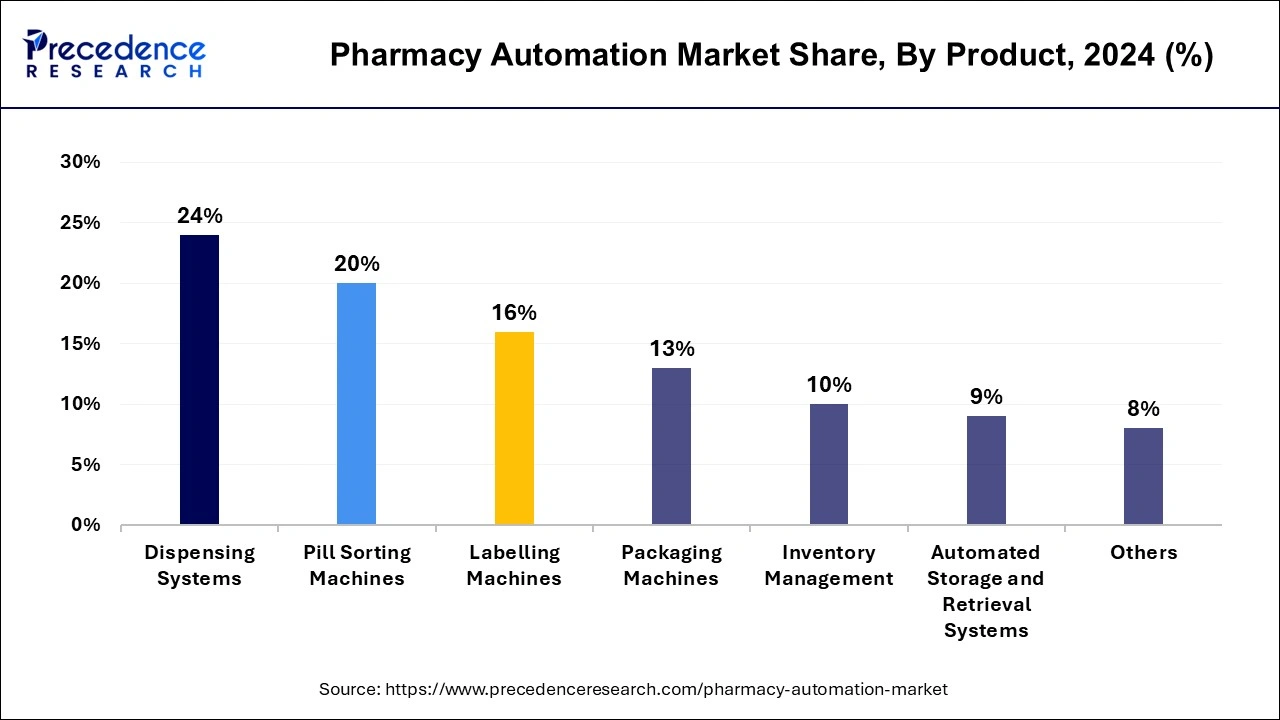
The automated medication compounding systems segment is projected to hit strong growth over the forecast period. As per the survey on pharmacy automation equipment done by Pharmacy Purchasing and Products in 2019, 84% of hospital pharmacies have or plan to employ automated dispensing cabinets. One of the primary factors driving the growth of the segment is the growing use of sterile compounding.
The retail pharmacy segment dominated the pharmacy automation market in 2023. The supermarket pharmacies, chain pharmacies, mass merchandiser pharmacies, and independent pharmacies are all examples of retail pharmacies. The growth of the segment is attributed to the rising need to reduce dispensing errors, the surge in the number of retail pharmacies, and increased burden on pharmacists.
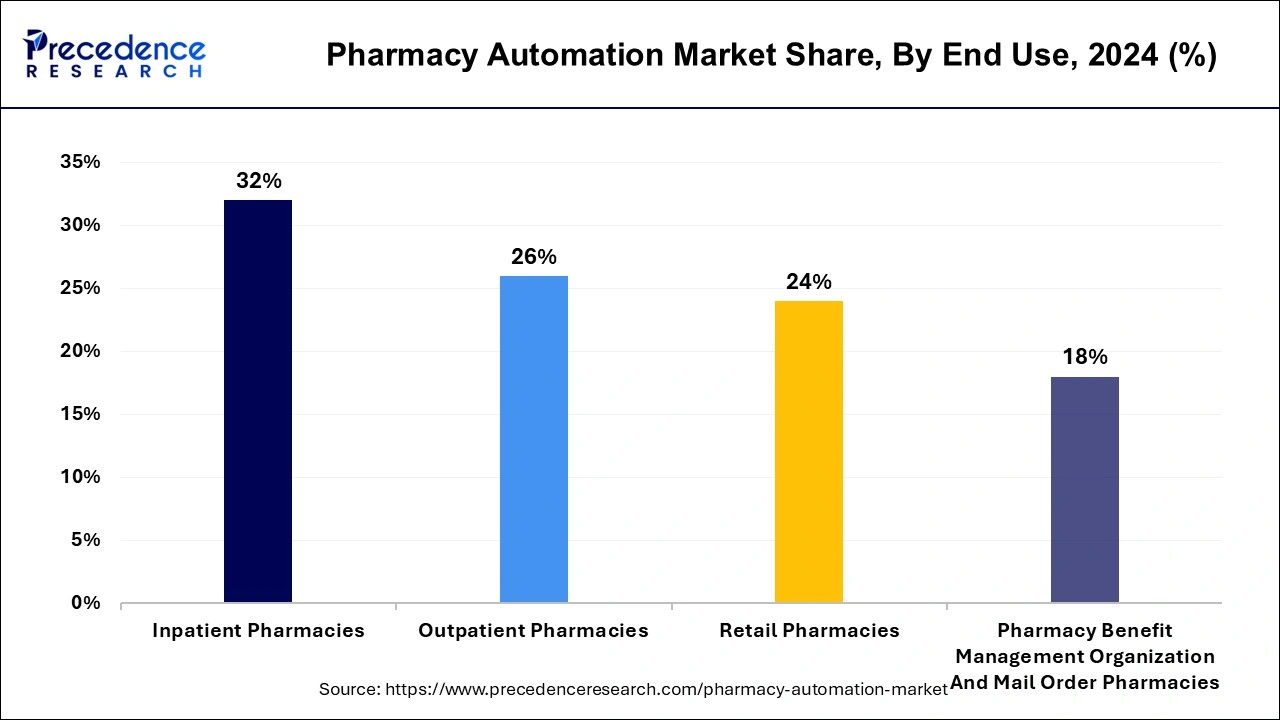
The hospital pharmacy segment is expected to witness significant growth over the forecast period. This is due to the growing use of automated dispensing cabinets, automated medication storage, and barcoded unit dose packaging systems to improve production and efficiency. In December 2020, for example, Owensboro Health implemented Omnicell Central Pharmacy Dispensing Service to decrease pharmaceutical dispensing problems and enhance inventory management.
By Product
By End Use
By Geography
For inquiries regarding discounts, bulk purchases, or customization requests, please contact us at sales@precedenceresearch.com
No cookie-cutter, only authentic analysis – take the 1st step to become a Precedence Research client
January 2025
July 2024
January 2025
July 2024